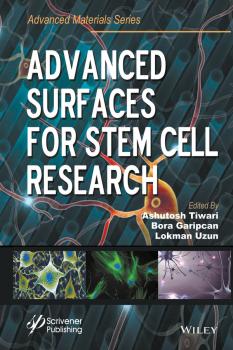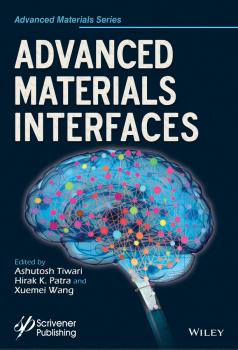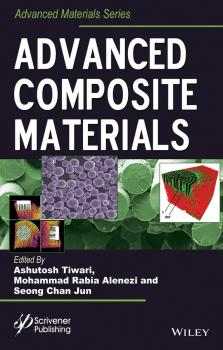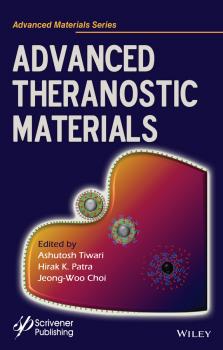ТОП просматриваемых книг сайта:















Ashutosh Tiwari
Список книг автора Ashutosh TiwariАннотация
The engineering of materials with advanced features is driving the research towards the design of innovative materials with high performances. New materials often deliver the best solution for structural applications, precisely contributing towards the finest combination of mechanical properties and low weight. The mimicking of nature's principles lead to a new class of structural materials including biomimetic composites, natural hierarchical materials and smart materials. Meanwhile, computational modeling approaches are the valuable tools complementary to experimental techniques and provide significant information at the microscopic level and explain the properties of materials and their very existence. The modeling also provides useful insights to possible strategies to design and fabricate materials with novel and improved properties. The book brings together these two fascinating areas and offers a comprehensive view of cutting-edge research on materials interfaces and technologies the engineering materials. The topics covered in this book are divided into 2 parts: Engineering of Materials, Characterizations & Applications and Computational Modeling of Materials. The chapters include the following: Mechanical and resistance behavior of structural glass beams Nanocrystalline metal carbides – microstructure characterization SMA-reinforced laminated glass panel Sustainable sugarcane bagasse cellulose for papermaking Electrospun scaffolds for cardiac tissue engineering Bio-inspired composites Density functional theory for studying extended systems First principles based approaches for modeling materials Computer aided materials design Computational materials for stochastic electromagnets Computational methods for thermal analysis of heterogeneous materials Modelling of resistive bilayer structures Modeling tunneling of superluminal photons through Brain Microtubules Computer aided surgical workflow modeling Displaced multiwavelets and splitting algorithms
Аннотация
This book covers the recent advances in electrode materials and their novel applications at the cross-section of advanced materials. The book is divided into two sections: State-of-the-art electrode materials; and engineering of applied electrode materials. The chapters deal with electrocatalysis for energy conversion in view of bionanotechnology; surfactant-free materials and polyoxometalates through the concepts of biosensors to renewable energy applications; mesoporous carbon, diamond, conducting polymers and tungsten oxide/conducting polymer-based electrodes and hybrid systems. Numerous approaches are reviewed for lithium batteries, fuel cells, the design and construction of anode for microbial fuel cells including phosphate polyanion electrodes, electrocatalytic materials, fuel cell reactions, conducting polymer based hybrid nanocomposites and advanced nanomaterials.
Аннотация
The book outlines first the importance of Extra Cellular Matrix (ECM), which is a natural surface for most of cells. In the following chapters the influence of biological, chemical, mechanical, and physical properties of surfaces in micro and nano-scale on stem cell behavior are discussed including the mechanotransduction. Biomimetic and bioinspired approaches are highlighted for developing microenvironment of several tissues, and surface engineering applications are discussed in tissue engineering, regenerative medicine and different type of biomaterials in various chapters of the book. This book brings together innovative methodologies and strategies adopted in the research and development of Advanced Surfaces in Stem Cell Research. Well-known worldwide researchers deliberate subjects including: Extracellular matrix proteins for stem cell fate The superficial mechanical and physical properties of matrix microenvironment as stem cell fate regulator Effects of mechanotransduction on stem cell behavior Modulation of stem cells behavior through bioactive surfaces Influence of controlled micro and nanoengineered surfaces on stem cell fate Nanostructured polymeric surfaces for stem cells Laser surface modification techniques and stem cells applications Plasma polymer deposition: a versatile tool for stem cell research Application of bioreactor concept and modeling techniques in bone regeneration and augmentation treatments Substrates and surfaces for control of pluripotent stem cell fate and function Application of biopolymer-based, surface modified devices in transplant medicine and tissue engineering Silk as a natural biopolymer for tissue engineering
Аннотация
Overall, this book presents a detailed and comprehensive overview of the state-of-the-art development of different nanoscale intelligent materials for advanced applications. Apart from fundamental aspects of fabrication and characterization of nanomaterials, it also covers key advanced principles involved in utilization of functionalities of these nanomaterials in appropriate forms. It is very important to develop and understand the cutting-edge principles of how to utilize nanoscale intelligent features in the desired fashion. These unique nanoscopic properties can either be accessed when the nanomaterials are prepared in the appropriate form, e.g., composites, or in integrated nanodevice form for direct use as electronic sensing devices. In both cases, the nanostructure has to be appropriately prepared, carefully handled, and properly integrated into the desired application in order to efficiently access its intelligent features. These aspects are reviewed in detail in three themed sections with relevant chapters: Nanomaterials, Fabrication and Biomedical Applications; Nanomaterials for Energy, Electronics, and Biosensing; Smart Nanocomposites, Fabrication, and Applications.
Аннотация
Advanced Material Interfaces is a state-of-the-art look at innovative methodologies and strategies adopted for interfaces and their applications. The 13 chapters are written by eminent researchers not only elaborate complex interfaces fashioned of solids, liquids, and gases, but also ensures cross-disciplinary mixture and blends of physics, chemistry, materials science, engineering and life sciences. Advanced interfaces operate fundamental roles in essentially all integrated devices. It is therefore of the utmost urgency to focus on how newly-discovered fundamental constituents and interfacial progressions can be materialized and used for precise purposes. Interfaces are associated in wide multiplicity of application spectrum from chemical catalysis to drug functions and the advancement is funnelled by fine-tuning of our fundamental understanding of the interface effects.
Аннотация
Composites materials is basically the combining of unique properties of materials to have synergistic effects. A combination of materials is needed to adapt to certain properties for any application area. There is an everlasting desire to make composite materials stronger, lighter or more durable than traditional materials. Carbon materials are known to be attractive in composites because of their combination of chemical and physical properties. In the recent years, development of new composites has been influenced by precision green approaches that restrict hazardous substances and waste created during production. This book ranges from the fundamental principles underpinning the fabrication of different composite materials to their devices, for example, applications in energy harvesting, memory devices, electrochemical biosensing and other advanced composite-based biomedical applications. This book provides a compilation of innovative fabrication strategies and utilization methodologies which are frequently adopted in the advanced composite materials community with respect to developing appropriate composites to efficiently utilize macro and nanoscale features. The key topics are: Pioneer composite materials for printed electronics Current-limiting defects in superconductors High-tech ceramics materials Carbon nanomaterials for electrochemical biosensing Nanostructured ceramics and bioceramics for bone cancer Importance of biomaterials for bone regeneration Tuning hydroxyapatite particles Carbon nanotubes reinforced bioceramic composite Biomimetic prototype interface
Аннотация
Ceramic materials are inorganic and non-metallic porcelains, tiles, enamels, cements, glasses and refractory bricks. Today, «ceramics» has gained a wider meaning as a new generation of materials influence on our lives; electronics, computers, communications, aerospace and other industries rely on a number of their uses. In general, advanced ceramic materials include electro-ceramics, optoelectronic-ceramics, superconductive ceramics and the more recent development of piezoelectric and dielectric ceramics. They can be considered for their features including mechanical properties, decorative textures, environmental uses, energy applications, as well as their usage in bio-ceramics, composites, functionally graded materials, intelligent ceramics and so on. Advanced Ceramic Materials brings together a group of subject matter experts who describe innovative methodologies and strategies adopted in the research and development of the advanced ceramic materials. The book is written for readers from diverse backgrounds across chemistry, physics, materials science and engineering, medical science, pharmacy, environmental technology, biotechnology, and biomedical engineering. It offers a comprehensive view of cutting-edge research on ceramic materials and technologies. Divided into 3 parts concerning design, composites and functionality, the topics discussed include: Chemical strategies of epitaxial oxide ceramics nanomaterials Biphasic, triphasic and multiphasic calcium orthophosphates Microwave assisted processing of advanced ceramic composites Continuous fiber reinforced ceramic matrix composites Yytria and magnesia doped alumina ceramic Oxidation induced crack healing SWCNTs vs MWCNTs reinforcement agents Organic and inorganic wastes in clay brick production Functional tantalum oxides Application of silver tin research on hydroxyapatite
Аннотация
Often described as a “miracle material”, graphene’s potential applications are extraordinary, ranging from nanoscale ‘green’ technologies, to sensors and future conductive coatings. This book covers the topic of ‘graphene’ – the history, fundamental properties, methods of production and applications of this exciting new material. The style of the book is both scientific and technical – it is accessible to an audience that has a general, undergraduate-level background in the sciences or engineering, and is aimed at industries considering graphene applications. As the graphene topic is a broad-reaching and rapidly moving field of research, the aim of this book is therefore to provide information about graphene and its current and future applications that are immediately implementable, relevant and concise. After reading this book, the reader will have sufficient knowledge and background to move forward independently into graphene R&D and to apply the knowledge therein. Although the book will be self-contained, each chapter has copious references to enable further reading, research and exploration of the chapter topics.
Аннотация
The present book is covers the recent advances in the development on the regulation of such theragnosis system and their biomedical perspectives to act as a future nanomedicine. Advanced Theranostics Materialsis written by a distinguished group of contributors and provides comprehensive coverage of the current literature, up-to-date overview of all aspects of advanced theranostics materials ranging from system biology, diagnostics, imaging, image-guided therapy, therapeutics, biosensors, and translational medicine and personalized medicine, as well as the much broader task of covering most topics of biomedical research. The books focusses on the following topics: Part 1: System biology and translational medicine Aberrant Signaling Pathways: Hallmark of Cancer Cells and Target for Nanotherapeutics Application of Nanoparticles in Cancer Treatment Biomacromolecule-Gated Mesoporous Silica Drug Delivery Systems Construction of Functional DNA Nanostructures for Theranostic Applications Smart Polypeptide Nanocarriers for Malignancy Therapeutics Part 2: Imaging and therapeutics Dimercaptosuccinic acid-coated magnetic nanoparticles as a localized delivery system in cancer immunotherapy Cardiovascular nanomedicine Chitosan-based systems for sustained drug release Nanocapsules in biomedicine: promises and challenges Chitosan-based polyelectrolyte complexes: characteristics and application in formulation of particulate drug carriers Part 3: Diagnostics and featured prognostics Non-invasive Glucose Biosensors based on Nanomaterials Self/directed Assembly of Nanoparticles: A review on various approaches Ion exchangers – an open window for the development of advanced materials with pharmaceutical and medical applications New Titanium Alloys for Biomedical Applications
Аннотация
This comprehensive and unique book is intended to cover the vast and fast-growing field of electrical and electronic materials and their engineering in accordance with modern developments. Basic and pre-requisite information has been included for easy transition to more complex topics. Latest developments in various fields of materials and their sciences/engineering, processing and applications have been included. Latest topics like PLZT, vacuum as insulator, fiber-optics, high temperature superconductors, smart materials, ferromagnetic semiconductors etc. are covered. Illustrations and examples encompass different engineering disciplines such as robotics, electrical, mechanical, electronics, instrumentation and control, computer, and their inter-disciplinary branches. A variety of materials ranging from iridium to garnets, microelectronics, micro alloys to memory devices, left-handed materials, advanced and futuristic materials are described in detail.










